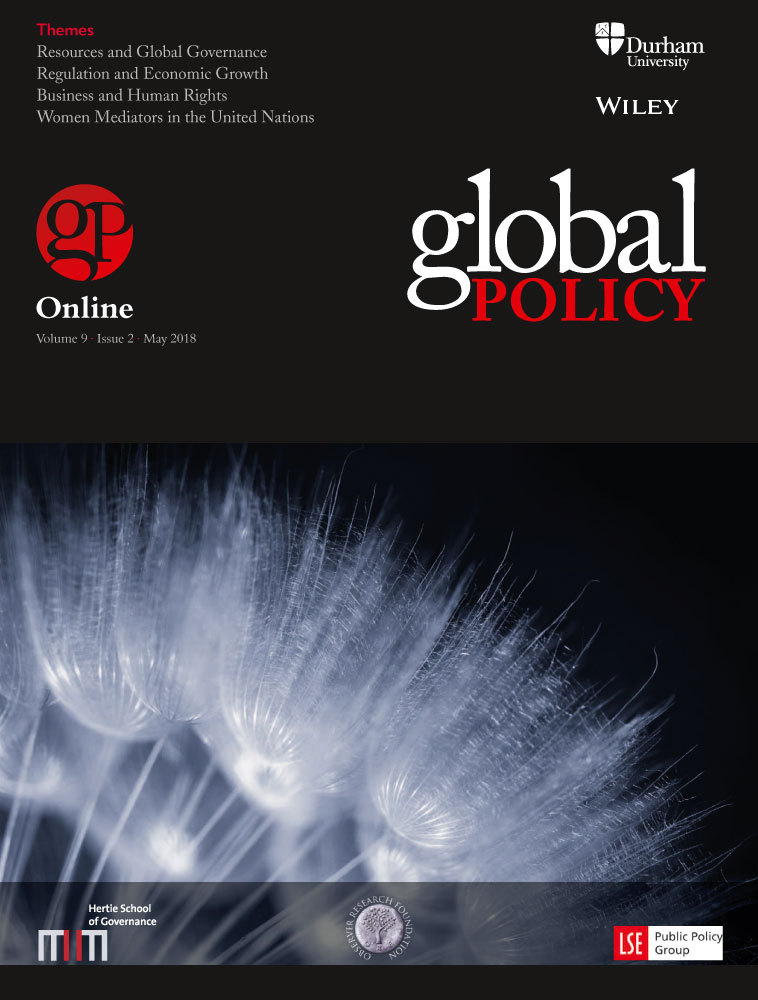Negotiating the Hard/Soft Law Divide in Business and Human Rights: The Implementation of the UNGPs in the European Union
Abstract
The article discusses the implementation of the UN Guiding Principles on Business and Human Rights (UNGPs) in the European Union against the backdrop of perennial debates between proponents of ‘hard’ versus ‘soft’ law approaches to preventing and redressing corporate-related human rights violations. It argues that the Open Method of Coordination (OMC) – an EU governance instrument of transnational policy-making – could contribute to negotiating the hard/soft law divide in business and human rights by ensuring a more effective implementation of the UNGPs in the European legal space. Moreover, the European experience with open coordination calls for a reappraisal of the relationship between international law and global governance in addressing today's business and human rights predicament. The first part of the article situates the debate between proponents of ‘hard’ and ‘soft’ law approaches to business and human rights in the context of two UN-driven initiatives: the development of national action plans (NAPs) to implement the UNGPs; and the negotiation of an international business and human rights treaty. The second part of the article relates experiences with the existing NAP process in the European Union to the policy background and rationale of the Open Method of Coordination and discusses the conditions for its successful employment in the business and human rights domain.
References
- ARD Monitor (2016) ‘ Lobbyismus auf Regierungsebene: Profit Statt Menschenrechte’, [online]. Available from: http://www1.wdr.de/daserste/monitor/sendungen/lobbyismus-104.html.
- Augenstein, D., Dawson, M. and Thielboerger, P. (2017) ‘ Towards an Open Method of Coordination for Business and Human Rights’, EUI Working Paper Law 2017/01. Fiesole: European University Institute.
- Boyle, A. (1999) ‘Some Reflections on the Relationship between Treaties and Soft Law’, International and Comparative Law Quarterly, 48 (4), pp. 901–913.
10.1017/S0020589300063739 Google Scholar
- Büchs, M. (2008) ‘How Legitimate is the Open Method of Coordination?’, Journal of Common Market Studies, 46 (9), pp. 765–786.
10.1111/j.1468-5965.2008.00804.x Google Scholar
- Büchs, M. (2007) New Governance in European Social Policy: The Open Method of Coordination. London: Palgrave MacMillan.
- Catá Backer, L. (2011) ‘On the Evolution of the United Nations’ “Protect-Respect-Remedy” Project: The State, the Corporation and Human Rights in a Global Governance Context’, Santa Clara Journal of International Law, 9 (1), pp. 37–80.
- Committee on the Elimination of Racial Discrimination (CERD) (2011), ‘ Concluding Observations: United Kingdom of Great Britain and Northern Ireland’, CERD/C/GBR/CO/18-20.
- Corporate Accountability, Forum Menschenrechte and Venro (2017), ‘ Kein Mut zu mehr Verbindlichkeit’, [online]. Available from: http://www.cora-netz.de/cora/ [Accessed 28 December 2017].
- Council of Europe (2016) ‘ Recommendation CM/Rec(2016)3 of the Committee of Ministers to the Member States on Human Rights and Business. Available from: https://edoc.coe.int/en/fundamental-freedoms/7302-human-rights-and-business-recommendation-cmrec20163-of-the-committee-of-ministers-to-member-states.html [Accessed 28 December 2017].
- Council of the European Union (2016) ‘ Council Conclusions on Business and Human Rights’, 10254/16. Available from: http://www.consilium.europa.eu/en/press/press-releases/2016/06/20/fac-business-human-rights-conclusions/ [Accessed 28 December 2017].
- Danish Government (2014) ‘ Danish National Action Plan: Implementation of the UN Guiding Principles on Business and Human Rights’.
- Danish Institute for Human Rights (DIHR) and International Corporate Accountability Roundtable (ICAR) (2014) ‘ National Action Plans on Business and Human Rights: A Toolkit for the Development, Implementation, and Review of State Commitments to Business and Human Rights Frameworks’. Available from: https://www.humanrights.dk/publications/national-action-plans-business-human-rights [Accessed 28 December 2017].
- Dawson, M. (2011) New Governance and the Transformation of European Law. Cambridge: Cambridge University Press.
10.1017/CBO9781139017442 Google Scholar
- de Schutter, O. (2015) ‘Towards a New Treaty on Business and Human Rights’, Business and Human Rights Journal, 1 (1), pp. 41–67.
10.1017/bhj.2015.5 Google Scholar
- Dutch Ministry of Foreign Affairs (2014) ‘ National Action Plan on Business and Human Rights’.
- European Commission (2010) ‘ Europe 2020: A Strategy for Smart, Sustainable and Inclusive Growth’, COM(2010) 2020 final.
- European Commission (2013) ‘ Peer Review Report: Peer Review on Corporate Social Responsibility’. Available from: http://ec.europa.eu/social/keyDocuments.jsp?advSearchKey=CSRprreport&mode=advancedSubmit&langId=en [Accessed 28 December 2017].
- European Commission (2014) Corporate Social Responsibility: National Public Policies in the European Union – Compendium 2014. Luxembourg: Publications Office of the European Union.
- European Commission (2015) ‘ Commission staff working document on Implementing the UN Guiding Principles on Business and Human Rights’, SWD(2015) 144 final.
- European Network of National Human Rights Institutions (ENNHRI) (2015), ‘ Recommendations for the next EU Strategy on CSR’. Available from: http://ennhri.org/ [Accessed 28 December 2017].
- European Parliament (2017) ‘ Implementation of the UN Guiding Principles on Business and Human Rights’, EP/EXPO/B/COMMITTEE/FWC/2013-08/Lot8/09.
- European Union (2015) ‘ Submission to the First Session of the Intergovernmental Working Group’.
- Fernanda Espinosa, M. (2017) ‘ Urgent Need for Legally Binding Obligations on Transnational Corporations (2/2)’, Interview with the Chair of the Working Group, Permanent Representative of Ecuador to the UN-Geneva. Geneva: UN TV.
- Finnish Ministry for Employment and the Economy (2014) ‘ National Action Plan for the implementation of the UN Guiding Principles on Business and Human Rights’.
- Fundamental Rights Agency (FRA) (2017) ‘ Improving Access to Remedy in the Area of Business and Human Rights at the EU Level’, FRA Opinion 1/2017 [B&HR], Vienna.
- German Government (2016) ‘ Nationaler Aktionsplan: Umsetzung der VN-Leitprinzipien für Wirtschaft und Menschenrechte 2016-2020‘.
- German Institute for Human Rights (2016) ‘ Zögerliche Umsetzung. Der politische Wille reicht nicht weiter: Deutschland setzt die VN-Leitprinzipien um – mit kleinen Schritten’, Berlin.
- Government of Ecuador (2013) ‘ Statement on Behalf of a Group of Countries at the 24th Session of the Human Rights Council: “Transnational Corporations and Human Rights”’. Available from: https://business-humanrights.org/sites/default/files/media/documents/statement-unhrc-legally-binding.pdf [Accessed 28 December 2017].
- Government Offices of Sweden (2015) ‘ Action Plan for Business and Human Rights’.
- Heidenreich, M. and Zeitlin, J. (2009) Changing European Employment and Welfare Regimes: The Influence of the OMC on National Reforms. London: Routledge.
- Human Rights Committee (2012) ‘ Concluding Observations on the sixth periodic report of Germany’, CCPR-C-DEU-CO-6.
- Human Rights Council (HRC) (2009) ‘ Business and Human Rights: Towards Operationalising the “Protect, Respect, and Remedy” Framework’, A/HRC/11/13.
- Human Rights Council (HRC) (2010) ‘ Business and Human Rights: Further Steps towards the Operationalisation of the “Protect, Respect, and Remedy” Framework’, A/HRC/14/27.
- Human Rights Council (HRC) (2011a) ‘ Guiding Principles on Business and Human Rights: Implementing the United Nations’ “Protect, Respect and Remedy” Framework’, A/HRC/17/31.
- Human Rights Council (HRC) (2011b) ‘ Human Rights and Transnational Corporations and Other Business Entities’, A/HRC/RES/17/4.
- Human Rights Council (HRC) (2014a) ‘ Elaboration of an international legally binding instrument on transnational corporations and other business enterprises with respect to human rights’, A/HRC/Res/26/9.
- Human Rights Council (HRC) (2014b), ‘ Human Rights and Transnational Corporations and Other Business Enterprises’, A/HRC/RES/26/22.
- Human Rights Council (HRC) (2016) ‘ Improving accountability and access to remedy for victims of business-related human rights abuse’, A/HRC/32/19.
- Human Rights Council (HRC) (2017) ‘ Report on the second session of the open-ended intergovernmental working group on transnational corporations and other business enterprises with respect to human rights’, A/HRC/34/47.
- Human Rights Watch (2013) ‘ Without Rules: A Failed Approach to Corporate Accountability’. Available from: https://www.hrw.org/sites/default/files/related_material/business.pdf [Accessed 28 December 2017].
- International Corporate Accountability Roundtable (ICAR) European Coalition for Corporate Justice (ECCJ) and Dejusticia (2017) ‘ Assessments of Existing National Action Plans (NAPs) on Business and Human Rights – August 2017 Update’. Available from: https://www.dejusticia.org/wp-content/uploads/2017/08/NAPAssessmentAug2017FINAL.pdf [Accessed 28 December 2017].
- International Corporate Accountability Roundtable and European Coalition for Corporate Justice (2014) ‘ Assessment of Existing National Action Plans on Business and Human Rights’. Available from: https://static1.squarespace.com/static/583f3fca725e25fcd45aa446/t/59998094cd39c36f1e0d1726/1503232152737/ICAR-ECCJ+Assessments+of+Existing+NAPs.pdf [Accessed 28 December 2017].
- Italian Government (2016) ‘ Italian National Action Plan on Business and Human Rights 2016–2021’.
- Jacobsson, K. and Vifell, A. (2003) ‘ Integration by Deliberation? On the Role of Committees in the Open Method of Coordination’, in E. O. Erikson, C. Joerges and J. Neyer (eds.), European Governance, Deliberation and the Quest for Democratisation. Oslo: Arena, pp. 411–450.
- Kerr, M., Janda, R. and Pitts, C. (2009) Corporate Social Responsibility: A Legal Analysis. Ontario: Butterworth Lexis Nexis.
- Kroger, S. (2008) Soft Governance in Hard Politics: European Coordination of Anti-Poverty Policies in France and Germany. Wiesbaden: VS Verlag.
- Lisbon European Council (2000) ‘ Presidency Conclusions’, [online]. Available from: http://www.europarl.europa.eu/summits/lis1_en.htm.
- Lopez, C. (2013) ‘ The “Ruggie process”: from legal obligations to corporate social responsibility?’, in S. Deva and D. Bilchitz (eds.), Human Rights Obligations of Business. Cambridge: Cambridge University Press, pp. 58–77.
10.1017/CBO9781139568333.006 Google Scholar
- Mares, R. (2010) ‘Global Corporate Social Responsibility, Human Rights and Law: An Interactive Regulatory Perspective on the Voluntary-Mandatory Divide’, Transnational Legal Theory, 1 (2), pp. 221–285.
10.1080/20414005.2010.11424508 Google Scholar
- McBarnet, D. (2007) ‘ Corporate social responsibility beyond law, through law, for law: the new corporate accountability’, in D. McBarnet, A. Voiculescu and T. Campbell (eds.), The New Corporate Accountability. Cambridge: Cambridge University Press, pp. 9–57.
- Neglia, M. (2016) ‘The UNGPs – Five Years On: From Consensus to Divergence in Public Regulation on Business and Human Rights’, Netherlands Quarterly of Human Rights, 34 (4), pp. 289–317.
- Netherlands Institute for Human Rights (2014) ‘ Response to the National Action Plan on Business and Human Rights “Knowing and Showing”’. Available from: https://www.mensenrechten.nl/publicaties/detail/34673 [Accessed 28 December 2017].
- Ruggie, J. (2014a) ‘ A UN Business and Human Rights Treaty?’, https://www.business-humanrights.org/.
- Ruggie, J. (2014b) ‘ A UN Business and Human Rights Treaty Update’, [online]. Available from: https://www.business-humanrights.org/.
- Ruggie, J. (2015) ‘ Regulating Multinationals: The UN Guiding Principles, Civil Society, and International Legalization’, Regulatory Policy Program Working Paper RPP-2015-04. Cambridge MA: Harvard Kennedy School.
- Ruggie, J. (2016) ‘ Incorporating human rights: lessons learnt, and next steps’, in D. Baumann-Pauly and J. Nolan (eds.), Business and Human Rights: From Principles to Practice. London: Routledge, pp. 64–50.
- Sabel, C. and Zeitlin, J. (2008) ‘Learning from Difference: The New Architecture of Experimentalist Governance in the EU’, European Law Journal, 14 (3), pp. 271–327.
- Scharpf, F. (2002) ‘The European Social Model: Coping with the Challenges of Diversity’, Journal of Common Market Studies, 40 (4), pp. 645–670.
- Scott, J. and Trubek, D. (2002) ‘‘Mind the Gap: Law and New Approaches to Governance in the European Union’, European Law Journal, 8 (1), pp. 1–18.
- Smismans, S. (2005) ‘ How to be Fundamental with Soft Procedures? The OMC and Fundamental Social Rights’, in G. Burca and B. Witte (eds.), Social Rights in Europe. Oxford: Oxford University Press, pp. 217–238.
10.1093/acprof:oso/9780199287994.003.0011 Google Scholar
- Tromp, D. (2016) ‘ Assessing Business Related Impacts on Human Rights: Indicators and Benchmarks in Standards and Practice’, INEF-Report 110/2016, [online]. Available from: https://inef.uni-due.de/cms/files/report110.pdf.
- Trubek, D. and Trubek, L. G. (2005) ‘Hard and Soft Law in the Construction of Social Europe: the Role of the Open Method of Coordination’, European Law Journal, 11 (3), 343–364.
10.1111/j.1468-0386.2005.00263.x Google Scholar
- UN Sub-Commission on the Promotion and Protection of Human Rights (2003) ‘ Norms on the Responsibilities of Transnational Corporations and Other Business Enterprises with Regard to Human Rights’, E/CN.4/Sub.2/2003/12.
- UN Working Group on Business and Human Rights (2016) ‘ Guidance on National Action Plans on Business and Human Rights’. Geneva: United Nations.
- UN Open-ended Intergovernmental Working Group on Business and Human Rights (OPIGWG), (2017) ‘ Elements for the draft legally binding instrument on transnational corporations and other business enterprises with respect to human rights (September 2017), [online]. Available from: http://www.ohchr.org/Documents/HRBodies/HRCouncil/WGTransCorp/Session3/LegallyBindingInstrumentTNCs_OBEs.pdf
- Visser, J. (2015) ‘ The OMC as Selective Amplifier for National Strategies for Reform’, in J. Zeitlin and P. Pochet (eds.), The Open Method of Coordination in Action: The European Employment and Social Inclusion Strategies. Brussels: Peter Lang, pp. 173–191.




